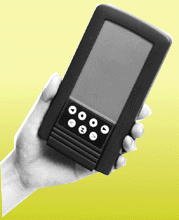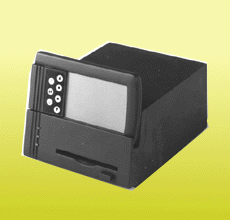

In April 1996, an electronic newspaper that uses unused television broadcasting frequencies to transmit articles will begin operating in the Tokyo area. Called E-NEWS, it was developed by the daily Sankei Shimbun, Fuji Television Network Inc., and other firms.
Articles from the Sankei Shimbun will be transmitted every morning to a receiver in the subscriber's home, and the information will then be read into a portable terminal, allowing the user to peruse it on the way to work or school. Electronic newspapers transmitted over personal computer networks are now common in the United States and elsewhere, but the is the world's first electronic newspaper to use ordinary TV broadcasting waves.
How E-NEWS Works
When the system is launched, about 90% (about 300,000 Japanese characters) of the articles in the final morning edition of the Sankei Shimbun issued in Tokyo will be transmitted to home receivers every morning between five and six o'clock using the pockets of unused frequencies owned by Fuji TV. The data transmitted will be coded, so a special decoder will be necessary to read it.
The receiver will consist of a desk-top station, containing the decoder and a floppy disc drive to record the decoded information, and the portable terminal. When all the transmitted data is read into the disc, the data can then be copied into the terminal's memory. The terminal will be small enough to fit into a pocket and display the articles any time or place on its liquid crystal display.
To read the paper, the user selects a topic from a 20-item menu that includes "From the Morning Paper" and "Stock Market Quotations," then browses for the desired article. For example, if an article from the morning paper is wanted, the user selects "From the Morning Paper" and picks the desired article from a number of headlines. The screen displays eight lines of 20 characters each, and the entire article can be read by scrolling.
Low Subscription Rates
The electronic newspapers on computer networks that are already available in the United States and elsewhere require the payment of a fee for the amount of time spent reading the paper. With TV waves, however, the user does not need to pay such a fee. E-NEWS plans for subscribers to pay an initial membership fee of 40,000 yen for the receiver and 1,200 yen per month for the service.
A TV newscaster in Japan uses about 10,000 letters during a 30-minute broadcast, while a reader who spends half an hour glancing through the paper covers approximately 60,000 characters. With the portable receiver--capable of holding up to 300,000 characters--subscribers will thus gain access to a huge volume of information every day.
E-NEWS will be provided by Electronic News Service, set up by Sankei, Fuji TV, and other participating firms. It aims for 20,000 subscribers in the initial year and 350,000 by the fifth year of operation. It also has plans to add new services in the coming years.
(The above article, edited by Japan Echo Inc., is based on domestic Japanese news sources. It is offered for reference purposes and does not necessarily represent the policy or views of the Japanese Government.)